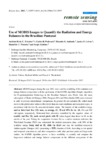Por favor, use este identificador para citar o enlazar este ítem:
http://www.alice.cnptia.embrapa.br/alice/handle/doc/1029921Registro completo de metadatos
| Campo DC | Valor | Lengua/Idioma |
|---|---|---|
| dc.contributor.author | TEIXEIRA, A. H. de C. | pt_BR |
| dc.contributor.author | PADOVANI, C. R. | pt_BR |
| dc.contributor.author | ANDRADE, R. G. | pt_BR |
| dc.contributor.author | LEIVAS, J. F. | pt_BR |
| dc.contributor.author | VICTORIA, D. de C. | pt_BR |
| dc.contributor.author | GALDINO, S. | pt_BR |
| dc.date.accessioned | 2015-11-30T11:11:11Z | pt_BR |
| dc.date.available | 2015-11-30T11:11:11Z | pt_BR |
| dc.date.created | 2015-11-30 | pt_BR |
| dc.date.issued | 2015 | pt_BR |
| dc.identifier.citation | Remote Sensing, v. 7, p. 14597-14619, 2015. | pt_BR |
| dc.identifier.uri | http://www.alice.cnptia.embrapa.br/alice/handle/doc/1029921 | pt_BR |
| dc.description | MODIS images during the year 2012 were used for modelling of the radiation and energy balance components with the application of the SAFER algorithm (Simple Algorithm for Evapotranspiration Retrieving) in the Brazilian Pantanal area. Pixels from the main sub-regions of Barão de Melgaço (BR), Paiaguás (PA) and Nhecolândia (NH) were extracted in order to process microclimatic comparisons. In general, the net radiation (Rn) relied much more on the global solar radiation (RG) levels than on water conditions and ecosystem types, in accordance with the low Rn standard deviation values. The fraction of the available energy used as latent heat flux (λE) were, on average, 65, 50 and 49% for the BR, PA and NH sub-regions, respectively. Horizontal heat advection, identified by the negative values of sensible heat flux (H), made several pixels with λE values higher than those for Rn in the middle of the year. Taking the evaporative fraction (Ef) as a surface moisture indicator, the Tree-Lined Savanna (TLS) was considered the moister ecosystem class, with 58% of the available energy being used as λE, while the driest one was the modified ecosystem Anthropogenic Changes (AC), presenting a λE/Rn fraction of 0.46. According to the spatial and temporal consistencies, and after comparisons with other previous point and large-scale studies, the SAFER algorithm proved to have sensibility to quantify and compare the large-scale radiation and energy balance components in the different ecosystems of the Brazilian Pantanal. The algorithm is useful for monitoring the energy exchange dynamics among the different terrestrial and aquatic ecosystem types throughout the seasons of the year. | pt_BR |
| dc.language.iso | por | pt_BR |
| dc.rights | openAccess | pt_BR |
| dc.subject | Evaporative fraction | pt_BR |
| dc.subject | Latent heat flux | pt_BR |
| dc.subject | Net radiation | pt_BR |
| dc.subject | Sensible heat flux | pt_BR |
| dc.title | Use of MODIS Images to Quantify the Radiation and Energy Balances in the Brazilian Pantanal. | pt_BR |
| dc.type | Artigo de periódico | pt_BR |
| dc.date.updated | 2016-03-17T11:11:11Z | pt_BR |
| dc.subject.nalthesaurus | Remote sensing | pt_BR |
| dc.subject.nalthesaurus | Wetlands | pt_BR |
| riaa.ainfo.id | 1029921 | pt_BR |
| riaa.ainfo.lastupdate | 2016-03-17 | pt_BR |
| dc.identifier.doi | 10.3390/rs71114597 | pt_BR |
| dc.contributor.institution | ANTONIO HERIBERTO DE C TEIXEIRA, CNPM; CARLOS ROBERTO PADOVANI, CPAP; RICARDO GUIMARAES ANDRADE, CNPM; JANICE FREITAS LEIVAS, CNPM; DANIEL DE CASTRO VICTORIA, CNPM; SERGIO GALDINO, CPAP. | pt_BR |
| Aparece en las colecciones: | Artigo em periódico indexado (CNPM)  | |
Ficheros en este ítem:
| Fichero | Descripción | Tamaño | Formato | |
|---|---|---|---|---|
| 4624.pdf | 1.57 MB | Adobe PDF |  Visualizar/Abrir |









